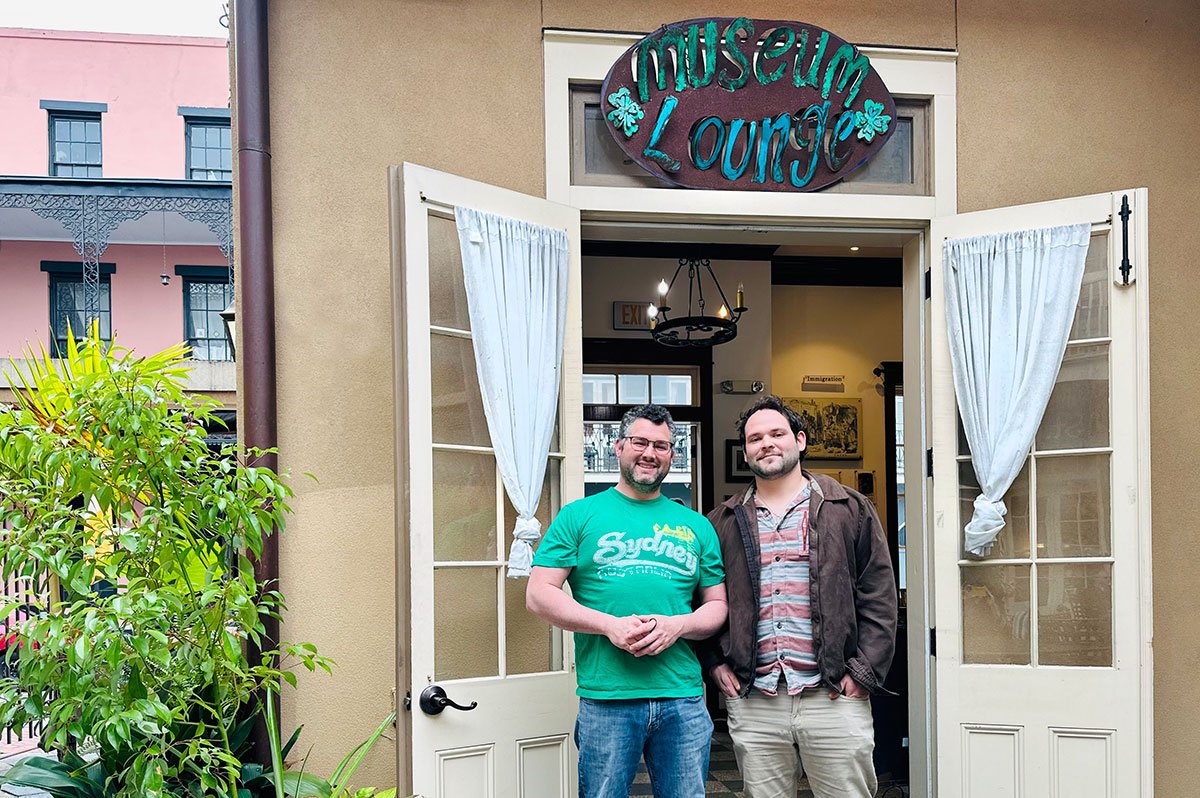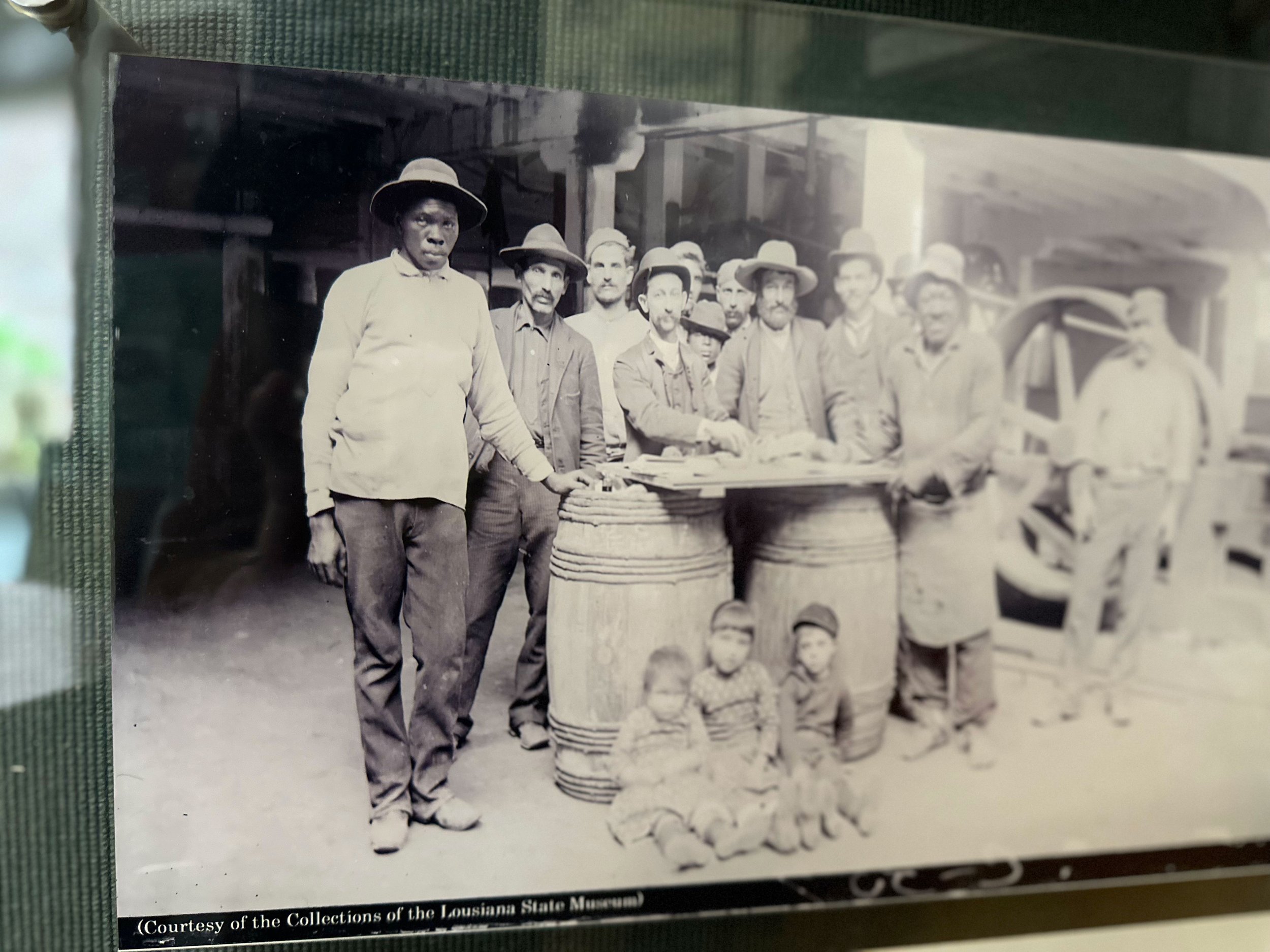The Irish Cultural Museum: St. Patrick’s Day Everyday
March 2023French Quarter visitors and locals alike can savor history, coffee – and of course, a large variety of Irish whiskeys – at this Emerald Isle oasis.
– By Dean M. Shapiro
Michael Ahearn smiles and shrugs when asked if the Irish Cultural Museum of New Orleans has any special plans for the upcoming Irish national holiday,
“Every day is St. Patrick’s Day here!” he said.
The museum, located at 933 Conti Street in the French Quarter, is the Ahearn family’s tribute to its ancestors and to the heritage of the Irish-Americans who make up a large portion of New Orleans’ population. Established in 2012 by the family patriarch, Matthew Ahearn, the museum is now co-managed by his three adult sons, Michael, Jacob and Luke.
This little piece of Ireland in the middle of the French Quarter consists of three parts: the actual museum with the formal displays is housed in a small cottage facing Conti Street. At the very back of the property is a second quaint building that’s a comfortable nest, serving as both coffee house and bar.
Between the two buildings a large flagstone patio offers a fountain and lush tropical plantings. The space is big enough to host small weddings or special events, in addition to the regular Sunday Irish music, poetry readings and storytelling performances (which starts around 6pm).
The museum can be reserved for private parties and weddings. Photo courtesy ICM FB page
Throughout, classical or Irish music plays softly in the background, giving the place the feel of an oasis of sorts, a respite from the cacophony of nearby Bourbon Street. Tourists are drawn in for a bit of rejuvenation and education, but locals have made it a favorite too.
“Coming here is a daily ritual for quite a few locals,” Michael said, “We have pedicab drivers, artists and cops – a lot of folks who live or work in the neighborhood.”
The Museum
Although relatively small in square footage, the museum manages to squeeze enough memorabilia into its space to capsulize the stories of prominent Irish families of New Orleans and their accomplishments – as well as other significant events in the city’s history that included Irish-Americans. Illustrated exhibit panels and full front pages of old newspapers in frames line the walls of the front room telling some of these stories and touting the contributions made by members of the New Orleans Irish community.
Visitors can follow the genealogy of the Livingston family which dates back to the 1670s and includes one of the authors of the Declaration of Independence – who also helped negotiate the Louisiana Purchase in 1803. They can read up on the family history of Andrew Jackson, victor of the Battle of New Orleans and the 7th president of the United States. The story of Oliver Pollock, one of the most prominent financiers of the American Revolution and the inventor of the U.S. dollar sign, is told here as well.
The exhibits also bemoan the centuries of oppression suffered by the Irish under British rule, as well as the tragedy of the Potato Famine of the late 1840s – a time when many people fled Ireland and settled in New Orleans.
Many Irish laborers worked alongside people of color to build the New Basin Canal and other major projects in New Orleans
One of the most significant accomplishments of the Irish highlighted here is the construction of the New Basin Canal in the mid-19th century. For over a hundred years, this waterway contributed to the growth of New Orleans as a major maritime hub. However, thousands of Irish canal diggers lost their lives in a cholera epidemic, Michael solemnly points out.
He also noted that a large number of Ulster Irish (from what is today designated Northern Ireland) fought against the British during the American Revolution. Some of these Irish patriots also sought to unify the two geographical divisions on the island, he added.
“These displays highlight and showcase some of those unsung heroes we’ve had in the city, immigrants who came over during the early period – especially during the Great Hunger of the Potato Famine,” Michael says.
Many of those who emigrated here settled in the uptown neighborhood that is still known today as the Irish Channel, with cottages a short walking distance from the river wharves where many of the men worked, Michael explains.
St. Patrick’s Coffee House
At the rear of the museum is the appropriately named St. Patrick’s Coffee House, a combination bar and coffee shop where between 20 and 30 different brand names of Irish whiskey are in stock, some of which go into the making of Irish coffee, Michael explained.
“This little coffee house helps tell the culinary story of the Irish coming to the city of New Orleans,” Michael said. “A lot of the cocktails we serve here are family recipes.”
“What a better way is there to talk about the different areas in Ireland than their famous domestic product: Irish whiskey? Many places produce their own very distinctive type of whiskey, so you can take a geographical tour of the country by sampling them.”
Michael launched into a detailed explanation of what makes Irish whiskey so distinct from other types of whiskey, a process that dates back over a thousand years. The difference, he said, lies primarily in how the barley mash is prepared in what is known as the “pot still” style.
And one of the reasons for developing this unique process stems largely from the way the British taxed grain-based products, he explained. The tax rate was lower for a product made for human consumption.
Michael’s dog, Laika, is a frequent visitor at the coffeehouse, entertaining guests.
“The Irish have a rich history of making a really fine distilled product,” Michael said. “The whiskey warms you up and gets you going in a cold climate.”
The Irish coffee served at the coffee house has its roots in an old family recipe developed by Michael’s grandmother and great-great grandfather at a bar they formerly owned at the corner of Canal and Royal streets.
Another feature of the museum is a small library of books, from which visitors can read about Irish heritage and accomplishments. Michael said he prefers that people read the books at the facility but occasionally he lets customers check them out – as long as they leave their contact information. Some of the books, however, are rare collector’s items and are not allowed to leave the premises. (The museum welcomes donations of books that focus on Irish-related subject matter).
What’s Ahead
Although the space is small, Michael says there are plans to expand. Eventually, the museum will include more exhibits, artifacts and other Irish-related memorabilia. The family has several research projects and documentaries on the back burner they’d like to publish. And there’s even an interactive app in the works that will feature museum highlights and more.
Eventually Michael would like to start a marching club and possibly even sponsor a float in one of the New Orleans area’s St. Patrick’s Day parades. He and his brothers are active with both the Ancient Order of Hibernians and the Irish Network of New Orleans.
But meanwhile, Michael and his family tell the stories of the unsung heroes and pay tribute to contributions made by descendants of the Emerald Isle.
“We’re a family-run spot – [the museum is] a labor of love for us all,” Michael said.
Michael shares family history with a family visiting from the Charleston area, repeat visitors to New Orleans and the museum.
The Irish Cultural Museum of New Orleans
933 Conti Street
(504) 272-0083
facebook.com/IrishCulturalMuseumOfNewOrleans
The museum is open Sunday through Thursday 8am-8pm and Friday & Saturday 8am-11pm
Your donations make stories like this one possible:











